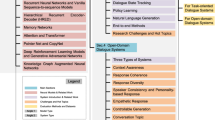Abstract
Dialogue systems have an increasingly higher number of applications and so their development is raising interest both in academic and industrial setting. Dialogue management is a key aspect for the development of these systems, as it is in charge of the decision making processes and the identification of the most appropriate responses to the user inputs. In this paper we compare different statistical techniques to train dialogue managers using generally available corpora at the disposal for the scientific community. Our results show that the use of generative models and in particular an intent classifier with Neural Networks and Seq2Seq using GRU cells attain the best accuracy for dialogue management.
The research leading to these results has received funding from the European Union’s Horizon 2020 research and innovation programme under grant agreement No. 823907 (MENHIR project: https://menhir-project.eu).
Access this chapter
Tax calculation will be finalised at checkout
Purchases are for personal use only
Similar content being viewed by others
Notes
- 1.
https://dstc9.dstc.community/ (Last access: June 2021).
References
Bahdanau, D., Cho, K., Bengio, Y.: Neural machine translation by jointly learning to align and translate. In: Bengio, Y., LeCun, Y. (eds.) Proceedings of the ICLR 2015 (2015)
Bartl, A., Spanakis, G.: A retrieval-based dialogue system utilizing utterance and context embeddings. In: Proceedings of the ICMLA 2017, pp. 1120–1125 (2017)
Bordes, A., Boureau, Y.L., Weston, J.: Learning end-to-end goal-oriented dialog. In: Proceedings of the ICLR 2017, pp. 1–15 (2017)
Fainberg, J., et al.: Talking to myself: self-dialogues as data for conversational agents. arXiv:1809.06641 (2018)
Griol, D., Callejas, Z., López-Cózar, R., Riccardi, G.: A domain-independent statistical methodology for dialog management in spoken dialog systems. Comput. Speech Lang. 28, 743–768 (2014)
Ham, D., Lee, J.G., Jang, Y., Kim, K.E.: End-to-end neural pipeline for goal-oriented dialogue systems using GPT-2. In: Proceedings of the ACL 2020, pp. 583–592 (2020)
Henderson, M., Thomson, B., Williams, J.D.: The second dialog state tracking challenge. In: Proceedings of the SIGDIAL 2014, pp. 263–272 (2014)
Henderson, M., Thomson, B., Williams, J.D.: The third dialog state tracking challenge. In: Proceedings of the SLT 2014, pp. 324–329 (2014)
Liu, Q., Bai, G., He, S., Liu, C., Liu, K., Zhao, J.: Heterogeneous relational graph neural networks with adaptive objective for end-to-end task-oriented dialogue. Knowl. Based Syst. 227, 107186 (2021)
Ma, Z., Du, B., Shen, J., Yang, R., Wan, J.: An encoding mechanism for seq2seq based multi-turn sentimental dialogue generation model. Procedia Comput. Sci. 174, 412–418 (2020)
Mateju, L., Griol, D., Callejas, Z., Molina, J., Sanchis, A.: An empirical assessment of deep learning approaches to task-oriented dialog management. Neurocomputing 439, 327–339 (2021)
McTear, M.: Conversational AI: Dialogue Systems, Conversational Agents, and Chatbots. Morgan and Claypool Publishers (2020)
McTear, M., Callejas, Z., Griol, D.: The Conversational Interface: Talking to Smart Devices. Springer, Switzerland (2016). https://doi.org/10.1007/978-3-319-32967-3
Zhao, T., Eskenazi, M.: Towards end-to-end learning for dialog state tracking and management using deep reinforcement learning. In: Proceedings of the SIGDIAL 2016, pp. 1–10 (2016)
Author information
Authors and Affiliations
Corresponding author
Editor information
Editors and Affiliations
Rights and permissions
Copyright information
© 2022 The Author(s), under exclusive license to Springer Nature Switzerland AG
About this paper
Cite this paper
Griol, D., Callejas, Z. (2022). A Comparison of Learning Approaches to Dialogue Management in Conversational Systems. In: Sanjurjo González, H., Pastor López, I., García Bringas, P., Quintián, H., Corchado, E. (eds) 16th International Conference on Soft Computing Models in Industrial and Environmental Applications (SOCO 2021). SOCO 2021. Advances in Intelligent Systems and Computing, vol 1401. Springer, Cham. https://doi.org/10.1007/978-3-030-87869-6_7
Download citation
DOI: https://doi.org/10.1007/978-3-030-87869-6_7
Published:
Publisher Name: Springer, Cham
Print ISBN: 978-3-030-87868-9
Online ISBN: 978-3-030-87869-6
eBook Packages: Intelligent Technologies and RoboticsIntelligent Technologies and Robotics (R0)




